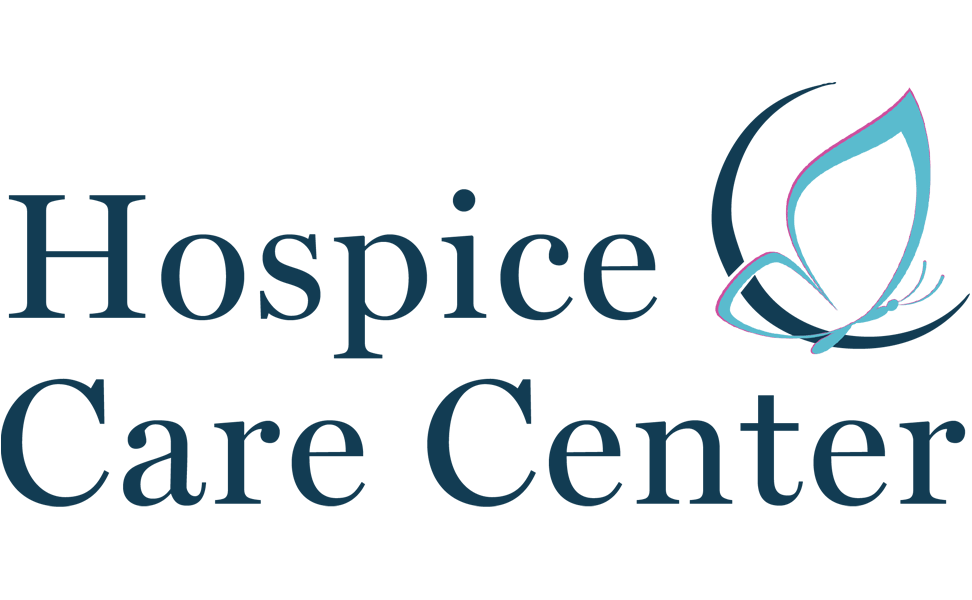Hospice is commonly misunderstood, even amongst healthcare professionals; learn more about what we do and when hospice may be appropriate
Welcome

Welcome to Hospice Care Center’s website and thank you for your interest. We are deeply honored to work with such outstanding people as the care team at Hospice Care Center. Together we are fully committed to meeting the needs of our patients and their families. We can think of nothing more important or fulfilling to us or our colleagues than caring for others and sharing life’s journey. Working with patients near the end of life and their families is a tremendous privilege, one that helps each of us grow as human beings and connects us together as a community.
At Hospice Care Center, the needs of our patients and their families come first. We will work closely with doctors and nurses in the community to support the care of seriously ill patients and to relieve suffering. We are happy to contribute personally to that care by communicating directly with physicians, assisting in symptom management, and providing care coordination.
We would be delighted to discuss our services, assist in pain and symptom management, or to answer any other questions you may have. We are proud of our colleagues and the outstanding work they do. Likewise we are honored and humbled to be part of such a wonderful community of caring.
The Hospice Care Center Care Team
We can provide support to identify hospice eligibility as well as helpful clinical guidelines
Admission Criteria
State and Federal regulations require that the following two criteria be met for a patient to be eligible for hospice care:
- Two physicians must certify the patient’s life expectancy is 6 months or less, if the illness runs its normal course.
- Patient has chosen care that focuses on symptom management rather than curative treatment.
Individuals eligible for Hospice Care Center’s services may experience some or all of the following:
- Frequent hospitalizations
- Progressive weight loss
- Deteriorating mental abilities
- Recurrent infections
- Decreased ability to perform Activities of Daily Living (ADLs)
- Hospice Care Center patients do not have to be homebound
Clinical Reference Scales
The following reference scales are used by healthcare professionals in various settings. These scales are incorporated in the Diagnosis Guidelines and are often documented by our clinical staff in the care of our patients.
New York Heart Association (NYHA) Functional Classification
Palliative Performance Scale (PPS)
Functional Assessment Staging Tool (FAST)
Body Mass Index (BMI) Reference Chart
Refer a PatientThese guidelines can help healthcare professionals to better determine potential hospice eligibility
Hospice Diagnosis Guidelines
The following Diagnosis Guidelines are for the most common illnesses. The guidelines are not required criteria for admission, but rather are guidelines adopted by the Centers for Medicare and Medicaid Services to assist physicians in determining hospice appropriateness.
- Adult Immuno-Deficiency Syndrome
- Amyotrophic Lateral Sclerosis
- Cancer
- Cardiac Disease
- Coma
- Dementia
- Liver Disease
- Pulmonary Disease
- Renal Disease
- Stroke
Adult Immuno-Deficiency Syndrome
Medical criteria for the terminal diagnosis of HIV disease are met if the patient has BOTH 1 and 2, with 3 providing supporting documentation, but not required:
1. CD4+ Count < 25 cells/mcL or persistent viral load > 100,000 copies/ml; AND ONE OF THE FOLLOWING:
- CNS lymphoma
- Untreated, or not responsive to treatment, wasting (loss of 33% lean body mass)
- Mycobacterium avium complex (MAC) bacteremia, untreated, unresponsive to treatment, or treatment refused
- Progressive multifocal leukoencephalopathy
- Systemic lymphoma, with advanced HIV disease and partial response to chemotherapy
- Visceral Kaposi’s sarcoma unresponsive to therapy
- Renal failure in the absence of dialysis
- Cryptosporidium infection
- Toxoplasmosis, unresponsive to therapy AND
2. Decreased performance status, as measured by the Karnofsky Performance Status (KPS) scale, of 50 or less 3. Documentation of the following factors will support eligibility for hospice care:
- Chronic persistent diarrhea for one year
- Persistent serum albumin < 2.5
- Concomitant substance abuse
- Age >50 years
- Absence of antiretroviral, chemotherapeutic and prophylactic drug therapy related specifically to HIV disease
- Advanced AIDS dementia complex
- Congestive heart failure, symptomatic at rest
- Chronic persistent diarrhea
If a patient meets the medical criteria above, they are by definition eligible to receive hospice services. Some patients may not meet the criteria, but may still be eligible for hospice care due to comorbidities or rapid functional decline.
Refer Your Patient
Amyotrophic Lateral Sclerosis
Patients will be considered to be in the terminal stage of ALS if they meet the following criteria (should fulfill 1, 2, or 3):
1. The patient should demonstrate critically impaired breathing capacity with ALL of the following characteristics in the past 12 months preceding initial hospice certification:
- Vital capacity (VC) < 30% of normal
- Significant dyspnea at rest
- Requiring supplemental 02 at rest
- Patient declines artificial ventilation OR
2. Patient should demonstrate BOTH: Rapid progression of ALS as demonstrated by ALL of the following within the 12 months preceding initial hospice certification:
- Progression from independent ambulation to wheelchair or bed-bound status
- Progression from normal to barely intelligible or unintelligible speech
- Progression from normal to pureed diet
- Progression from independence in most or all activities of daily living (ADLs) to needing major assistance by caretaker in all ADLs. AND
Critical nutritional impairment as demonstrated by ALL of the following within 12 months preceding initial hospice certification:
- Oral intake of nutrients and fluids insufficient to sustain life
- Continuing weight loss
- Dehydration or hypovolemia
- Absence of artificial feeding methods OR
3. BOTH of the following: Rapid progression of ALS (2.A. above) AND
Life-threatening complications as demonstrated by ONE of the following within the last 12 months preceding initial hospice certification:
- Recurrent aspiration pneumonia (with or without tube feedings)
- Upper UTI, e.g. , pyelonephritis
- Sepsis
- Recurrent fever after antibiotic therapy
- Decubitus ulcers, multiple, Stage 3-4
- In end-stage ALS, two factors are critical in determining prognosis: ability to breathe, and to a lesser extent, ability to swallow.
If a patient meets the medical criteria above, they are by definition eligible to receive hospice services. Some patients may not meet the criteria, but may still be eligible for hospice care due to comorbidities or rapid functional decline.
Refer Your Patient
Cancer
Patients will be considered to be in the terminal stage of cancer if they meet the following criteria (1 and 2 should be present):
1. Definitive Diagnosis
- Patient has tissue diagnosis of a malignancy that may be metastatic
- Patient has received optimal treatment for their cancer or they do not wish further treatment
- Patient has been on an investigational protocol or clinical trial and has failed on that protocol or trial and they do not wish further treatment
- Patient is not a candidate for any further treatment
- Patient has experienced severe complications from their treatment(s), e.g., radiation burns, pain, nausea and vomiting, fatigue/debility, etc. and they do not wish further treatment
- Individuals who have chosen care that focuses on symptom management rather than curative treatment
- Patient or family has decided to focus on quality vs. quantity of life
- Patient or family wishes palliative measures or comfort care
2. Presumptive Diagnosis
- Diagnostic work-up by imaging techniques revealed a mass or multiple lesions consistent with a widely spread malignancy
- Patient is not a candidate for aggressive chemotherapy or radiation therapy
- Patient or family do not wish any treatment(s)
- Patient or family wish palliative/symptom management or comfort care
If a patient meets the medical criteria above, they are by definition eligible to receive hospice services. Some patients may not meet the criteria, but may still be eligible for hospice care due to comorbidities or rapid functional decline.
Refer Your Patient
Cardiac Disease
Patients will be considered to be in the terminal stage of cardiac disease if they meet the following criteria (1 and 2 should be present; factors from 3 lend supporting documentation, but are not required):
1. At the time of initial certification or recertification for hospice: Patient is already optimally treated with diuretics and vasodilators, which may include Angiotensin-converting enzyme (ACE) inhibitors or the combination of hydrolyzing and nitrates. If side effects, such as hypotension or hyperkalemia, prohibit the use of ACE inhibitors or the combination of hydrolyzing and nitrates, this should be documented in the medical records; OR Patients having angina pectoris, at rest, resistant to standard nitrate therapy and are either not candidates or decline invasive procedures. AND
- Unable to carry on any physical activity without symptoms
- Symptoms are present even at rest
- If any physical activity is undertaken, symptoms are increased
- Treatment resistant symptomatic supraventricular or ventricular arrhythmias
- History of cardiac arrest or resuscitation
- History of unexplained syncope
- Brain embolism of cardiac origin
- Concomitant HIV disease
- Documentation of ejection fraction of 20% or less
If a patient meets the medical criteria above, they are by definition eligible to receive hospice services. Some patients may not meet the criteria, but may still be eligible for hospice care due to comorbidities or rapid functional decline.
Refer Your Patient
Coma
The medical criteria listed below would support a terminal prognosis for individuals with a diagnosis of coma (any etiology). Comatose patients with any 3 of the following on day three of coma are considered terminal:
- Abnormal brain stem response
- Absent verbal response
- Absent withdrawal response to pain
- Serum creatinine > 1.5 mg/dl
If a patient meets the medical criteria above, they are by definition eligible to receive hospice services. Some patients may not meet the criteria, but may still be eligible for hospice care due to comorbidities or rapid functional decline.
Refer Your Patient
Dementia
Patients will be considered to be in the terminal stage of dementia if they meet the following criteria (BOTH 1 and 2):
1. Stage 7 on the Functional Assessment Staging (FAST) Scale, described as:
- Unable to ambulate without assistance
- Unable to dress without assistance
- Unable to bathe without assistance
- Urinary and fecal incontinence, intermittent or constant
- No consistently meaningful verbal communication: stereotypical phrases only or the ability to speak is limited to six or fewer intelligible words
2. Patients should have had one of the following within the past 12 months:
- Aspiration pneumonia
- Pyelonephritis or upper urinary tract infection
- Septicemia
- Decubitus ulcers, multiple, stage 3-4
- Fever, recurrent after antibiotics
- Inability to maintain sufficient fluid and calorie intake demonstrated by either of the following:
- 10% weight loss during the previous six months OR < 2.5 gm/dl
If a patient meets the medical criteria above, they are by definition eligible to receive hospice services. Some patients may not meet the criteria, but may still be eligible for hospice care due to comorbidities or rapid functional decline.
Refer Your Patient
Liver Disease
Patients will be considered to be in the terminal stage of liver disease if they meet the following criteria (1 and 2 should be present; factors from 3 will lend supporting documentation):
1. The patient has end stage liver disease as evidenced by BOTH of the following:
- Prothrombin time prolonged more than 5 seconds over control, or International Normalized Ratio (INR) > 1.5 AND Serum albumin < 2.5 gm/dl AND
2. The patient shows at least ONE of the following:
- Ascites, refractory to treatment or patient non-compliant
- Spontaneous bacterial peritonitis
- Hepatorenal syndrome (elevated creatinine and BUN with oliguria (<400ml/day) and urine sodium concentration < 10 mEq/l)
- Hepatic encephalopathy, refractory to treatment, or patient non-compliant
- Recurrent variceal bleeding, despite intensive therapy
3. Documentation of the following factors will support eligibility for hospice care:
- Progressive malnutrition
- Muscle wasting with reduced strength and endurance
- Continued active alcoholism (> 80 gm ethanol/day)
- Hepatocellular carcinoma
- HBsAg (Hepatitis B) positivity
- Hepatitis C refractory to interferon treatment
Patients awaiting liver transplant who otherwise fit the above criteria may be certified for the Medicare hospice benefit, but if a donor organ is procured, the patient should be discharged from hospice.
If a patient meets the medical criteria above, they are by definition eligible to receive hospice services. Some patients may not meet the criteria, but may still be eligible for hospice care due to comorbidities or rapid functional decline.
Refer Your Patient
Pulmonary Disease
Patients will be considered to be in the terminal stage of pulmonary disease if they meet the following criteria (1 and 2 should be present; factors 3, 4 and/or 5 provide supporting documentation):
1. Severe chronic lung disease as documented by both:
- Disabling dyspnea at rest, poorly or unresponsive to bronchodilators, resulting in decreased functional capacity, e.g., bed to chair existence, fatigue, and cough [documentation of Forced Expiratory Volume in one second (FEV1), after bronchodilator, less than 30% of predicted is objective to obtain].
- Progression of end stage pulmonary disease, as evidenced by increasing visits to the emergency department or hospitalizations for pulmonary infections and/or respiratory failure (documentation of serial decrease in FEV1 of greater than 40 ml/year is objective evidence for disease progression, but is not necessary to obtain).
2. Hypoxemia, as evidenced by: Oxygen saturation of 88% or less on room air O2 < = 55 mm Hg (These values may be obtained from recent hospital records.)
Documentation of the following factors may provide additional support for end stage pulmonary disease.
3. Cor pulmonale or right heart failure (RHF) secondary to pulmonary disease (e.g., not secondary to left heart disease or valvulopathy).
4. Unintentional progressive weight loss of greater than 10% of body weight over the preceding six months.
5. Resting tachycardia > 100/min.
If a patient meets the medical criteria above, they are by definition eligible to receive hospice services. Some patients may not meet the criteria, but may still be eligible for hospice care due to comorbidities or rapid functional decline.
Refer Your Patient
Renal Disease
Patients will be considered to be in the terminal stage of renal disease if they meet the following criteria:
Acute Renal Failure (1, 2 AND 3 should be present; factors from 4 will lend supporting documentation):
- The patient is not seeking dialysis or renal transplant. AND
- Creatinine clearance < 10 cc/min (< 15 cc/min. for diabetes) AND
- Serum creatinine > 8.0 mg/dl (> 6.0 mg/dl for diabetes)
- Supporting documentation of comorbidities:
- History of mechanical ventilation
- Malignancy (other organ system)
- Chronic lung disease
- Advanced cardiac disease
- Advanced liver disease
- Sepsis
- Immunosuppression/AIDS
- Albumin < 3.5 gm/d
- Cachexia
- Platelet count < 25,000
- Disseminated intravascular coagulation
- Gastrointestinal bleeding
Chronic Renal Failure (1, 2, and 3 should be present; factors from 4 will lend supporting documentation):
- The patient is not seeking dialysis or renal transplant. AND
- Creatinine clearance < 10 cc/min (< 15 cc/min. for diabetes) AND
- Serum creatinine > 8.0 mg/dl (> 6.0 mg/dl for diabetes)
- Supporting documentation of comorbidities:
- Uremia
- Urine output < 400 cc/day
- Intractable hyperkalemia (> 7.0) not responsive to treatment
- Uremic pericarditis
- Hepatorenal syndrome
- Intractable fluid overload, not responsive to treatment
If a patient meets the medical criteria above, they are by definition eligible to receive hospice services. Some patients may not meet the criteria, but may still be eligible for hospice care due to comorbidities or rapid functional decline.
Refer Your Patient
Stroke
1. Poor functional status with a Palliative Performance Scale (PPS) of 40 or less. All criteria in number 1 should be met:
- Mainly bed-bound
- Unable to do work
- Requires maximal assistance to perform self-care
- Food/fluid intake are normal/reduced
- Either fully conscious or drowsy/confused
2. Inability to maintain hydration and caloric intake with ONE of the following:
- Weight loss > 10% during previous 6 months
- Weight loss > 7.5% in previous 3 months
- Serum albumin < 2.5 gm/dl
- Current history of pulmonary aspiration without effective response to speech language pathology interventions to improve dysphagia and decrease aspiration events
- Calorie counts documenting inadequate caloric/fluid intake
- Dysphagia severe enough to prevent the patient from receiving food/fluids that is necessary to sustain life in a patient who does not receive artificial nutrition/hydration
3. Documentation of medical complications within the previous 12 months, in the context of progressive clinical decline, will help support eligibility for hospice care.
- Recurrent or intractable infections such as pneumonia or other URI
- Urinary tract infection
- Sepsis
- Refractory stage 3-4 decubitus ulcers
- Fever recurrent after antibiotics
Refer Your Patient
Our goal is to be an extension of your patient care (not a replacement)
When you refer your patient to Hospice Care Center, you can trust us to surround that patient with a highly skilled team of hospice professionals. The team will work together, and with you if you wish, to develop a plan of care for your patient. Every patient situation is unique, so we start with your diagnosis and referral as we meet with the patient and caregiver(s) to hear their desires. Once everyone is on the same page, we craft a care plan that is specific in addressing the stated goals of the patient and family.
How We Care for Your Patients

- We will provide all medications, durable medical equipment (DME), and medical supplies related to the illness we are managing
- We will provide care 24 hours / 7 days a week
- We will never charge our patients or families anything for the services we provide
- We are additional care to what you provide – we do not replace your care or expect your patient relationship to cease – but instead look forward to coordinating care with you
What Your Patients Want
- 83% of Americans want to die at home, cared for by loved ones, and supported by in-home care professionals, according to findings of a national survey conducted by the National Hospice and Palliative Care Organization
- 88% of respondents said they would consider using hospice if they or someone they knew were terminally ill
- 98% of respondents whose family had previously been served by hospice said it was a positive experience

Respondents said the most important aspects of a good death were:
- Dying with family members present
- Dying with dignity
- Dying pain free
- Dying with the benefit of spiritual counseling
Having Difficult Decisions
We know how challenging end-of-life conversations can be, whether with a new patient or someone you have known for decades. We are available to work with you and your nursing staff to discuss approaches to demystify the discussion. We know that as patients and their families become better educated regarding their choices, and better understand the benefits of comfort care, that their decisions change. This recent New York Times article, “Seeking a Beautiful Death” summarizes these insights brilliantly.
The Hospice Philosophy
The hospice philosophy holds that end-of-life care should emphasize quality of life. A nationwide Gallup survey conducted for the National Hospice and Palliative Care Organization produced five key outcomes:
1. An overwhelming majority of adults said they would be interested in the comprehensive program of care at home that hospice programs provide. Yet most Americans know little or nothing about their eligibility for or availability of hospice services.
2. When asked to name their greatest fear associated with death, respondents most cited “being a burden to family and friends,” followed by “pain” and “lack of control.” Addressing the whole range of physical and psychological needs of the patient and his or her family in an interdisciplinary way is what makes hospice care so special.
3. 90% of adults believe it is the family’s responsibility to care for the dying. Hospice provides families with the support needed to keep their loved one at home, and can take over fully to give the caretaker short “respite” periods.
4. Most adults believe it would take a year or more to adjust to the death of a loved one. However, only 10% of adults have ever participated in a bereavement program or grief counseling following the death of a loved one. Hospice programs offer one year of grief counseling for the surviving family and friends.
Hospice can be confusing – we have provided an extensive collection of research
Resources

Below you will find information about access to pharmacies and medication information, details about billing for physician visits, research materials, and links pertinent to end-of-life care in America.
Abstracts, Journal References and Hospice Articles
